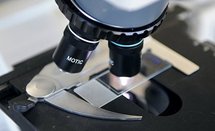
They used a transmission electron microscope to analyse a single layer of film made from boron nitride, where they were able to distinguish boron atoms from nitrogen atoms, as well as unwanted atoms of oxygen and carbon.
The technique involves transmission electron microscopy, which sends a narrow beam of electrons through a wafer-thin sample.
Some of the electrons are scattered, depending on the density of the sample.
The unscattered ones strike a screen at the bottom of the microscope, creating a "shadow image" formed by interaction between the electrons with atoms in the sample.
The core technology in transmission electron microscopy dates back to 1931.
But getting an atom-by-atom image has been hampered by problems in getting electromagnetic lenses to focus the beam on the sample, and in damage to the sample caused by the electrons themselves.
The breakthrough stems from optics that correct the lens aberration and from a so-called annular dark-field method that is sensitive to the atomic number (the number of protons in the nucleus) of the imaged atoms, according to Nature.
The study is led by Ondrej Krivanek of Nion Co., a company based in Kirkland, Washington state, that specialises in electron microscopy.
German-born physicist Erwin Mueller is credited as the first person to see individual atoms, a feat he realised in 1955 using a field ion microscope.
------------------------------------------------------------------------------------
The technique involves transmission electron microscopy, which sends a narrow beam of electrons through a wafer-thin sample.
Some of the electrons are scattered, depending on the density of the sample.
The unscattered ones strike a screen at the bottom of the microscope, creating a "shadow image" formed by interaction between the electrons with atoms in the sample.
The core technology in transmission electron microscopy dates back to 1931.
But getting an atom-by-atom image has been hampered by problems in getting electromagnetic lenses to focus the beam on the sample, and in damage to the sample caused by the electrons themselves.
The breakthrough stems from optics that correct the lens aberration and from a so-called annular dark-field method that is sensitive to the atomic number (the number of protons in the nucleus) of the imaged atoms, according to Nature.
The study is led by Ondrej Krivanek of Nion Co., a company based in Kirkland, Washington state, that specialises in electron microscopy.
German-born physicist Erwin Mueller is credited as the first person to see individual atoms, a feat he realised in 1955 using a field ion microscope.
------------------------------------------------------------------------------------









 Home
Home Politics
Politics









